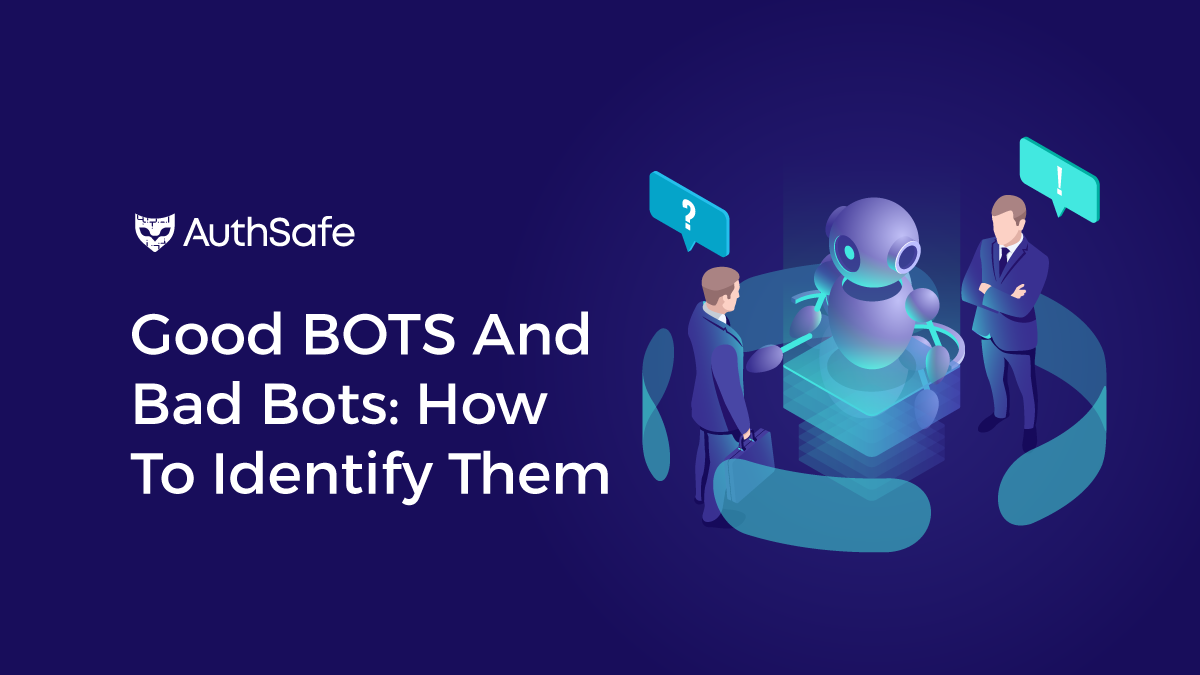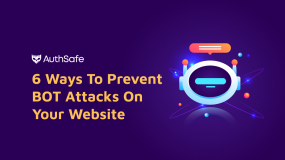
You’ve probably heard a lot about bots these days. Bots have been around for a long time. In fact, 56% of all website traffic originates from bots. They play an important role in the development of the internet, and users generally accept their use.
However, there are also harmful bots designed to inject malware, which is often very difficult to identify. This article will focus on what defines good bots and bad bots and how you can identify and differentiate between the two.
But first thing first.
What is a bot?
A bot is a program that runs automated tasks over the internet. These bots can be programmed to perform simple tasks, like posting on social media or replying to emails, or more complex activities, like buying and selling products, analyzing data and determining trends, and even automating customer service.
The most common types of bots are web crawlers (bots that scour the internet), chatbots (bots that interact with humans via text), and spambots (bots that send spam emails). Other types include social media bots (which spread fake news) and political bots (which spread propaganda).
What is a Good Bot?
Good bots are computer programs that help humans with their online activities. Search engines often use good bots for indexing web pages and helping people find what they’re looking for.
For example, Google uses several algorithms to determine which websites are relevant to a search query. Some of these algorithms use information from the links on other websites to determine how relevant a site is to your query, while others use keywords found in your query and then check those words against all the content on the page you’re visiting.
However, these algorithms will only work if they can access all of the information on your screen; otherwise, they’ll just try to guess what you mean when you type in something like “pizza.”
That’s where good bots come in: They help search engines like Google ensure that all the relevant information about pizza restaurants appears in their results pages so that users can easily find what they’re looking for without having to go through dozens of pages at once!
Examples of Good Bots
Here are some examples of good bots.
1. Search engine bots
These bots crawl your content to index it for search engines so that users can find your site when they search for a relevant topic.
2. Social network bots
These bots work on social media platforms like Facebook and Instagram to provide users with content or help them perform tasks like liking posts or sending messages.
3. Aggregator bots
Aggregator bots collect and organize information from various websites into one place, like a news feed or Twitter feed. They’re also helpful in identifying potential sources of traffic for your business.
4. Site monitoring bots
Bots like Uptime help users monitor their websites by tracking traffic data, identifying errors, and providing alerts when something goes wrong.
5. Voice engine bots
Voice engine bots are used in voice apps such as Siri, Alexa, and Google Assistant. They are also known as voice assistants because they provide verbal answers to questions asked by users instead of typing into a search engine like Google or Bing.
What is a Bad Bot?
A bad bot is a computer program that interacts with websites without the website owner’s permission. Individuals or companies often use these programs to gain unauthorized access to personal information, such as credit card numbers and other sensitive data.
Bad bots are typically used to spam search engines with links to malicious websites and advertisements. Hackers may also use them to perform denial-of-service attacks on websites or steal information from users who visit those sites.
The most common type of bad bot is a malicious script that scans the internet for vulnerable websites and then uses them to send spam emails. These scripts are often installed on hacked computers by hackers who want to use their resources to make money from fake sales or subscriptions.
Examples of Bad Bots
Here are some examples of good bots.
1. Scraper bots
These bots scrape data from sites and feed it into search engines. Anyone can use them, but marketers and businesses often employ them to gather information about competitors’ websites or find out what potential customers are looking for online.
2. Spam bots
These bots flood websites with spam, either for their gain or for the benefit of a third party (such as an advertiser). They are typically designed to respond to requests for information and send back unsolicited advertisements or links to other websites.
3. Scalper bots
Scalper bots are used by people who want to buy tickets at lower prices than they are being sold for on the venue’s website or ticketing app.
These bots will purchase all available tickets at once and then resell them at higher prices on secondary markets such as eBay or Craigslist before they go on sale to the general public later in the day or week (depending on how far in advance you’re purchasing tickets).
4. Account takeover bots
An account takeover bot is a type of bot that uses the login information of a real user to access their account. Cybercriminals often use them to gain access to an account and steal personal information. If your account has been compromised, contact your bank immediately.
5. Carding and card-cracking bots
Carding and card-cracking bots are designed to steal credit card information from retailers’ websites. These bots gather the information necessary to create fake credit cards, which they then use to purchase goods online or over the phone.
This can also result in fraudulent charges on existing cards that have been compromised and identity theft issues for those who have their information stolen this way.
How to identify a Good bot and a Bad bot?
Identifying a good bot from a bad one can be tough, but it’s not rocket science. Good bots help with data scraping, indexing websites, and automating processes.
On the flip side, bad bots are designed to harm, spam, and steal valuable information. To distinguish between the two, keep an eye out for signs such as the frequency of requests, behavior patterns, and traffic source.
Here is how you can identify a good bot from a bad bot.
1. Robots.txt
This file tells crawlers what parts of your site they should and shouldn’t access. If a bot requests this file, but you don’t have one, it could be an automated request meant to identify vulnerabilities in your site security.
2. IP addresses
IP addresses are integers that identify devices connected to the internet and can be used to differentiate good bots from bad ones. Good bots typically have static IPs, while bad bots tend to have dynamic IPs that change over time. You can determine if an IP address is static or dynamic by running it through an IP lookup tool.
3. User-agent
Good bots use a user-agent string associated with search engines like Google or Bing. On the other hand, bad bots don’t follow this convention but can be identified by their behavior, like hitting multiple pages in a short period or clicking on links that are not relevant to your website’s content.
How to avoid Bad Bots?
There are several things you can do about bad bots. Here are a few tips:
1. Implement IP Blocking
One of the simplest and most effective ways to block bad bots is by implementing IP blocking. You can specify a list of IP addresses you want to block from accessing your website.
You can create a list of known bad IP addresses and block them or use a third-party service that provides a list of IP addresses of known bad bots. This will prevent them from accessing your website and wasting your bandwidth.
2. Use CAPTCHA
Another effective way to prevent bad bots from accessing your website is using a CAPTCHA. CAPTCHA is a security feature that requires the user to prove that they are human by performing a simple task, such as typing a series of characters or solving a simple puzzle. This makes it difficult for bots to access your website as they are unable to perform the task.
3. Use User-Agent Blocking
User-Agent Blocking is another useful technique that can be used to block bad bots. The User-Agent is a string of text sent by a web browser to the server when it requests a page. You can block bad bots by specifying a list of user agents you want to block. This will prevent bad bots using specified user agents from accessing your website.
4. Implement HTTP Authentication
HTTP Authentication is a security feature requiring a user to enter a username and password to access a website. This can be used to prevent bad bots from accessing your website as they cannot provide the required credentials.
Depending on your needs, you can set up HTTP Authentication for specific pages or your entire website.
5. Monitor Your Website Traffic
Monitoring your website traffic is an important part of avoiding bad bots. By monitoring your traffic, you can identify patterns of bad bot activity and take steps to prevent it.
You can use tools like Google Analytics or other website monitoring tools to monitor your website traffic and take action if you detect any suspicious activity.
6. Get expert help
Finally, get some help from a cybersecurity expert like AuthSafe, who knows how to deal with these issues and protect your site and business.
Conclusion
The distinction between good and bad bots is crucial to maintaining online security and privacy. Good bots are essential to automating repetitive tasks and enhancing the user experience, while bad bots can pose a threat to online security by engaging in malicious activities. These include hacking, scraping sensitive data, and spreading malware.
To effectively differentiate between good and bad bots, it is essential to understand their behavior patterns and utilize tools like IP reputation databases, HTTP header analysis, and behavioral analysis to make an informed decision.
Keeping up-to-date with the latest technological advancements and protecting against bad bots is crucial for maintaining a safe and secure online experience.
So, always stay vigilant, keep an eye out, and distinguish the good & bad bots to protect your privacy and security in the digital world. Bots are here to stay, so we must learn how to promote and restrict their use. For more information, connect to us today.



